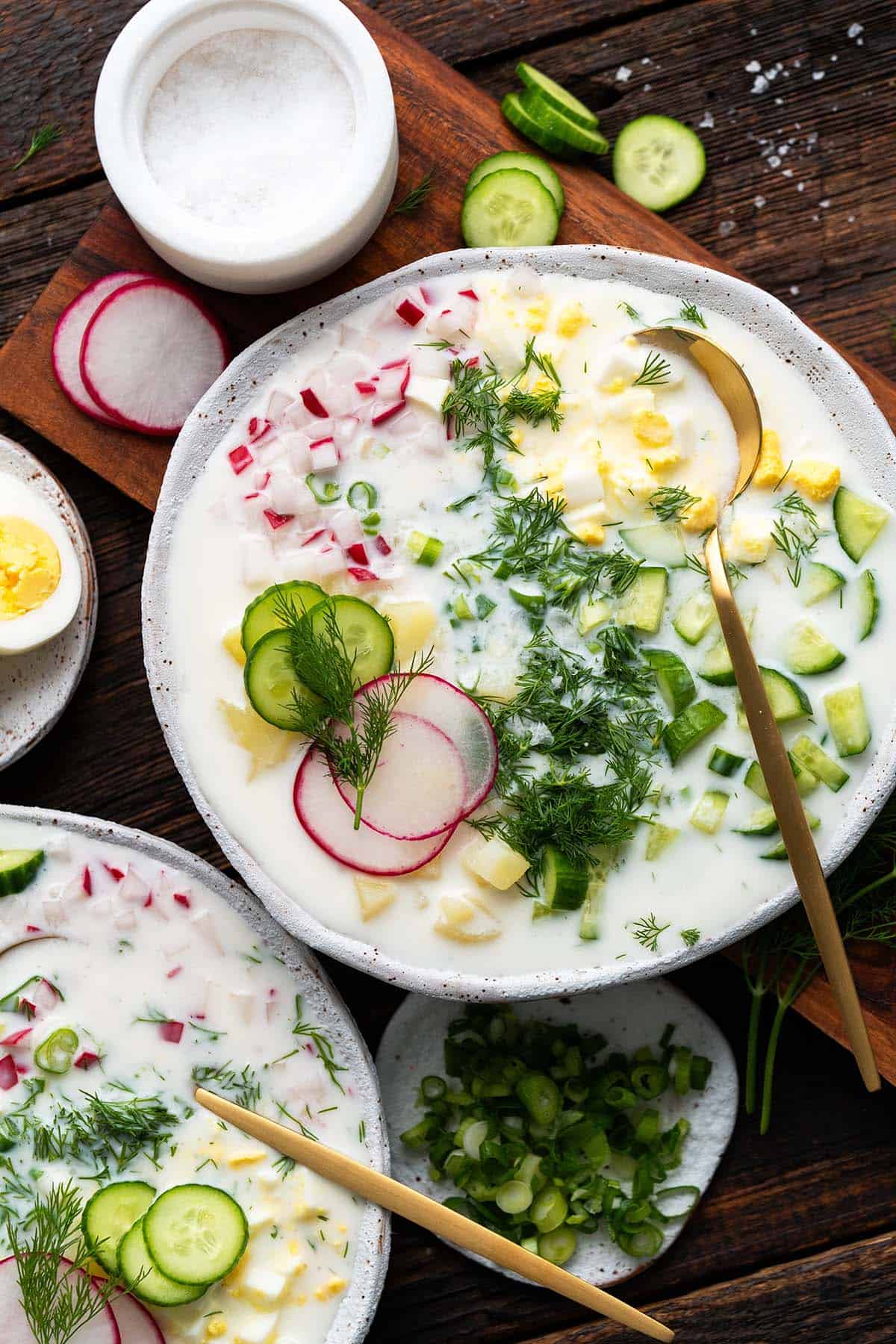Exploring the world of Asian soups opens up a treasure trove of flavors and traditions. These recipes bring together a diverse range of ingredients and cooking techniques from various Asian cultures. Why settle for the usual when you can savor something more exciting and unique?
From the delicate and comforting to the fiery and hearty, these soups offer a dish for every palate and occasion. You’ll find options that cater to different tastes and dietary preferences, making it easy to discover new favorites.
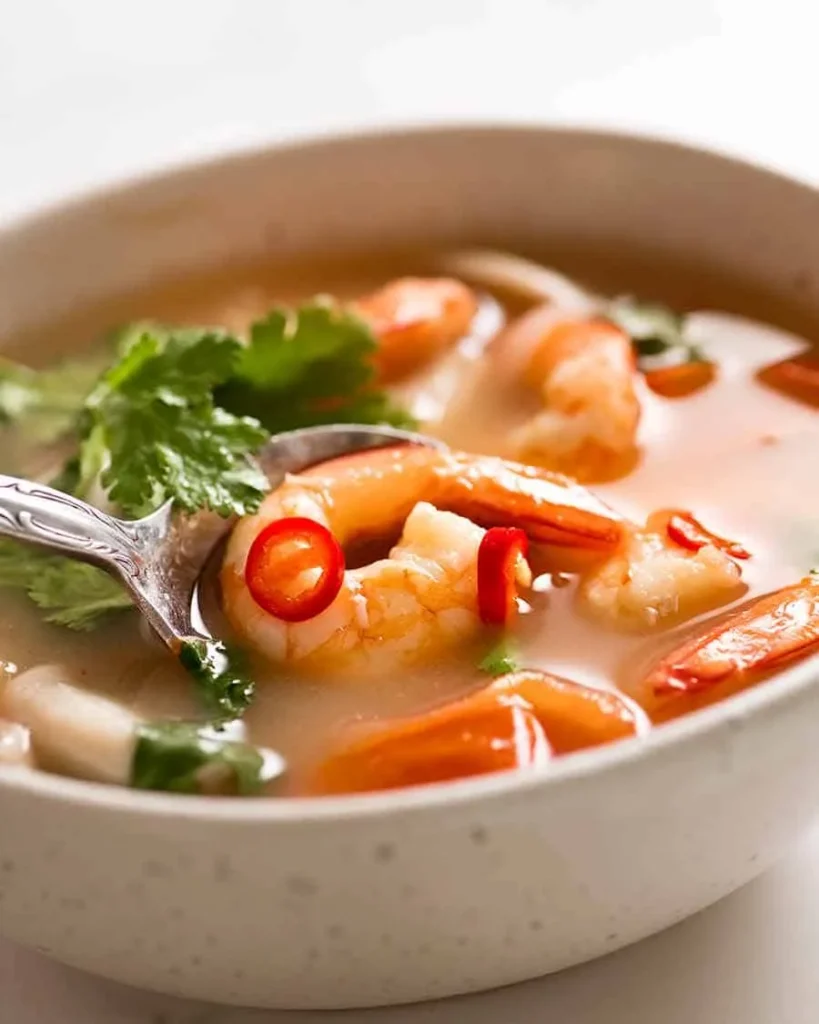
1) Tom Yum Soup
Tom Yum Soup is one of the most loved Thai dishes. Known for its vibrant and bold flavors, it combines sour and spicy elements in a perfect balance. This soup is often made with shrimp, but you can also use chicken or tofu.
The key ingredients in Tom Yum Soup are lemongrass, galangal, and makrut lime leaves. These ingredients create its distinctive fragrance. Fresh shrimp heads and shells are often used to make a rich broth, enhancing the soup’s flavor.
To make the soup, you start by stir-frying the shrimp shells and heads in a bit of oil until they turn bright orange. Then, add water and let it simmer to extract the flavors. Strain the broth to remove the solids.
Next, add sliced lemongrass, galangal, and makrut lime leaves to the broth. These herbs infuse the soup with their aromatic qualities. Simmer for about 5 minutes to allow the flavors to meld.
Add in mushrooms and let them cook for a couple of minutes. Then, put your shrimp into the broth. Allow the residual heat to cook the shrimp perfectly without making them tough.
Finish off by adding some Thai chilies and lime juice to give the soup its signature sour and spicy taste. Enjoy your Tom Yum Soup with a side of rice for an authentic Thai experience.
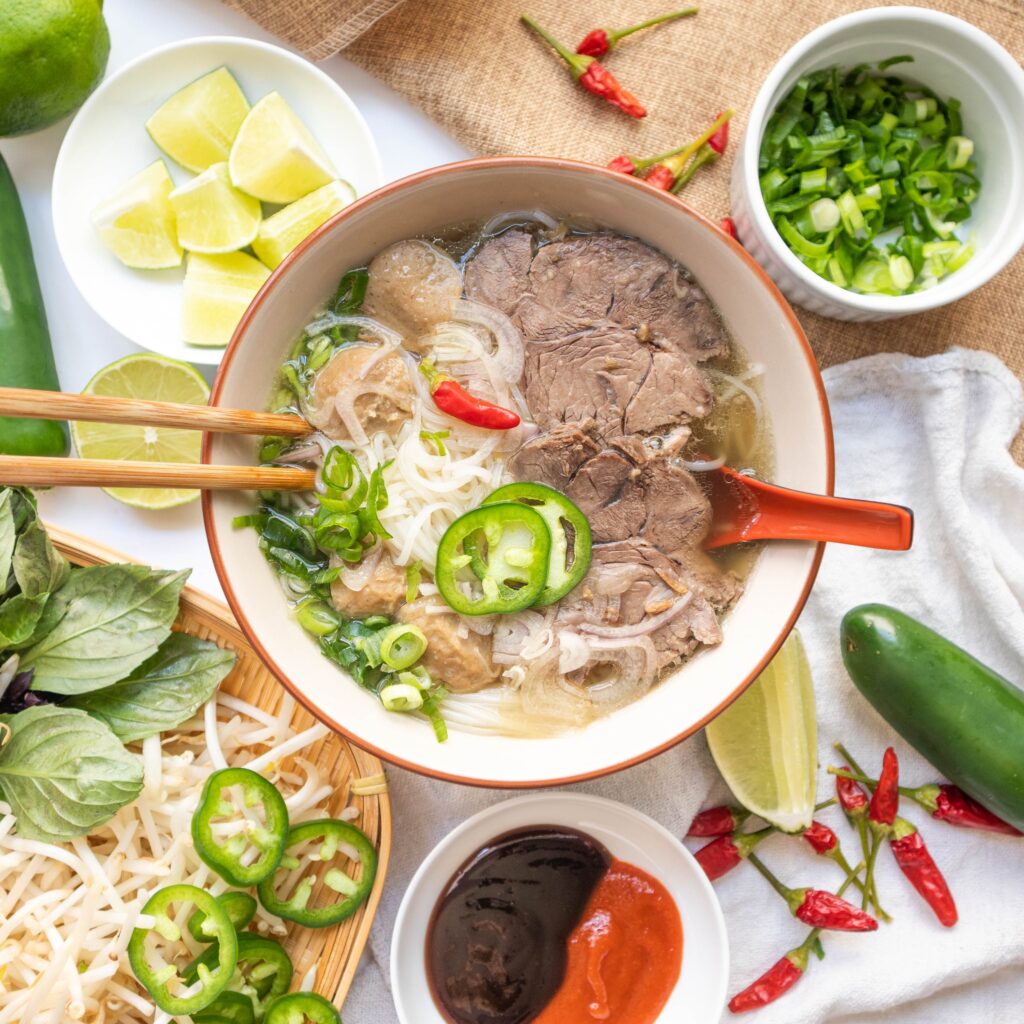
2) Pho Bo
Pho Bo is a traditional Vietnamese beef noodle soup.
To begin, you need beef bones for the broth. Clean the bones by par-boiling and then rinsing them. Once clean, simmer the bones in water to draw out their rich flavors.
Next, add spices to the broth. Common spices include cinnamon, star anise, and coriander. Charred onion and ginger also go into the pot for extra depth.
The broth should simmer for several hours. This slow cooking process helps develop a deep, aromatic flavor. You may also want to add fish sauce and a bit of rock sugar for sweetness.
For the meat, thinly slice beef sirloin and cook some beef brisket. Prepare the rice noodles by boiling them until tender.
When assembling the bowl, place the noodles in first, then add the sliced meats. Pour the hot broth over the top. Garnish with fresh herbs like cilantro and green onions.
Pho Bo is best enjoyed hot. Customize it with lime, chili peppers, and bean sprouts based on your taste.
This dish is not only comforting but also a great way to explore Vietnamese cuisine. Use quality ingredients and take your time to achieve authentic flavors.
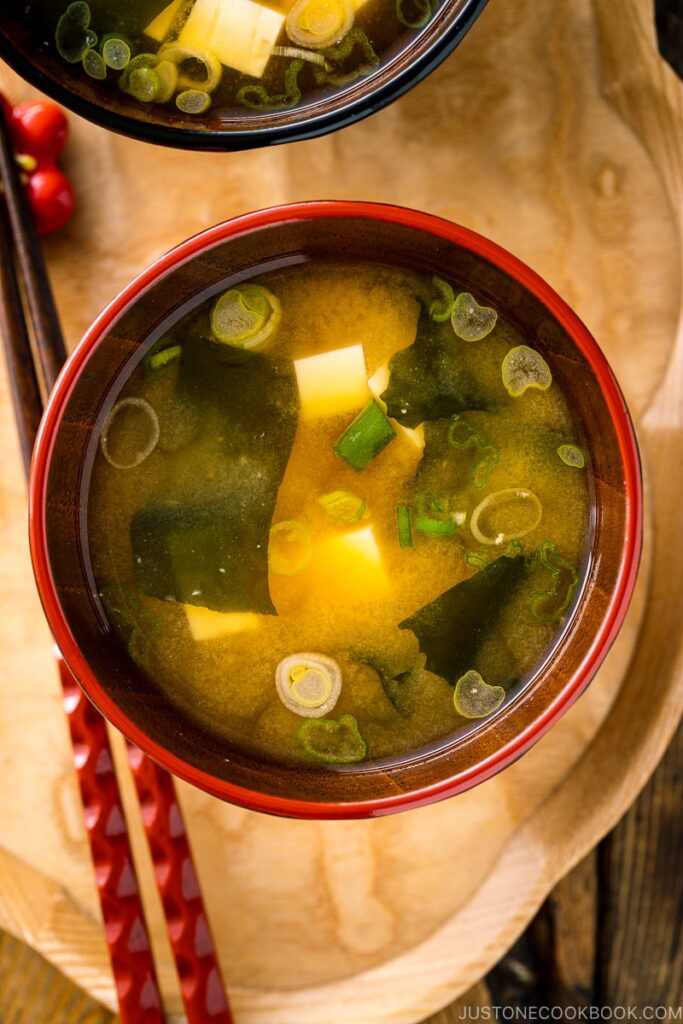
3) Miso Soup
Miso soup is a classic Japanese dish that is both nutritious and comforting. It’s commonly made with a few key ingredients like miso paste, dashi, tofu, and wakame seaweed.
To prepare, start by dissolving miso paste in a small amount of dashi to avoid clumps. Never boil the miso paste, as it can lose its flavor and aroma.
Add tofu and wakame to the hot dashi. Let the wakame soak and rehydrate for about 15 minutes before adding it to the soup. Include sliced green onions for an extra layer of taste.
For best results, simmer the soup gently for 2 to 3 minutes before serving. This brief cooking time ensures that the delicate flavors remain intact.
Miso soup is versatile, making it suitable for breakfast, a light lunch, or dinner. Its simple yet rich taste makes it a staple in many Japanese households.
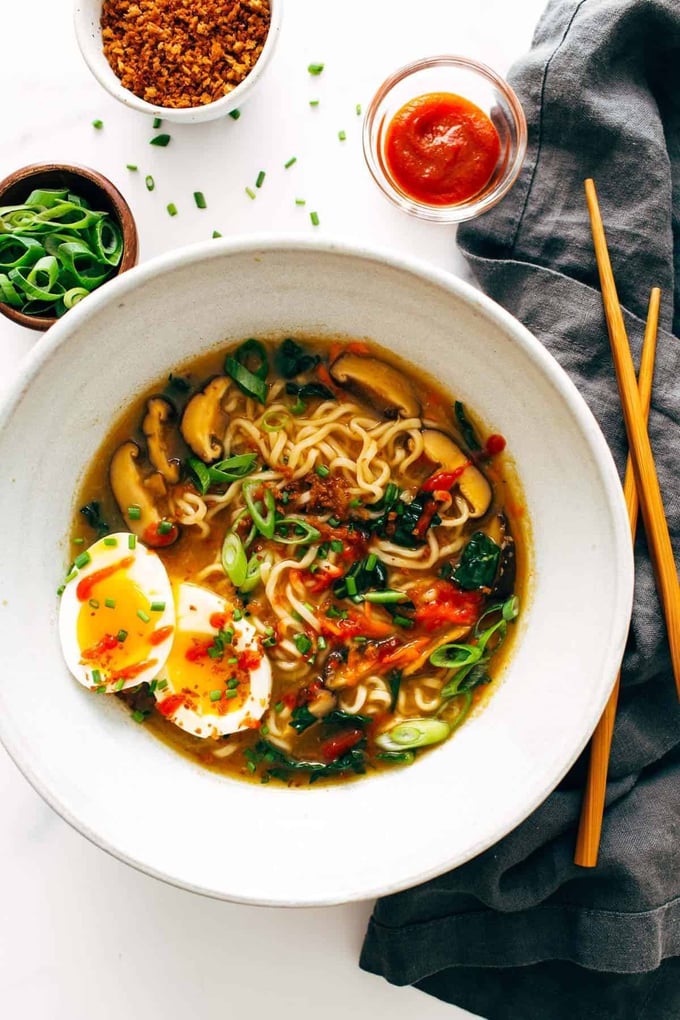
4) Ramen
Ramen is a beloved dish that originated in Japan. It features a flavorful broth, noodles, and various toppings. There are many types of ramen, each with unique ingredients and flavors. One popular variation is Miso Ramen. This type of ramen has a savory broth made from pork and chicken, flavored with miso paste.
You can also enjoy Shio Ramen. This ramen has a clear and salty broth. It often includes ingredients like lemon rinds and kombu, a type of seaweed. If you want a simple yet tasty option, try making it at home using a few basic ingredients.
For those who enjoy a bit of spice, consider Spicy Ramen. This version involves adding chili sauce or red curry paste. It creates a hot and flavorful experience. Other common ingredients include garlic, ginger, and scallions, which add depth to the broth.
Ramen is a versatile dish with endless customization options. You can mix and match ingredients like mushrooms, soy sauce, and fish sauce to suit your taste. Try different broths and toppings to find your favorite combination.
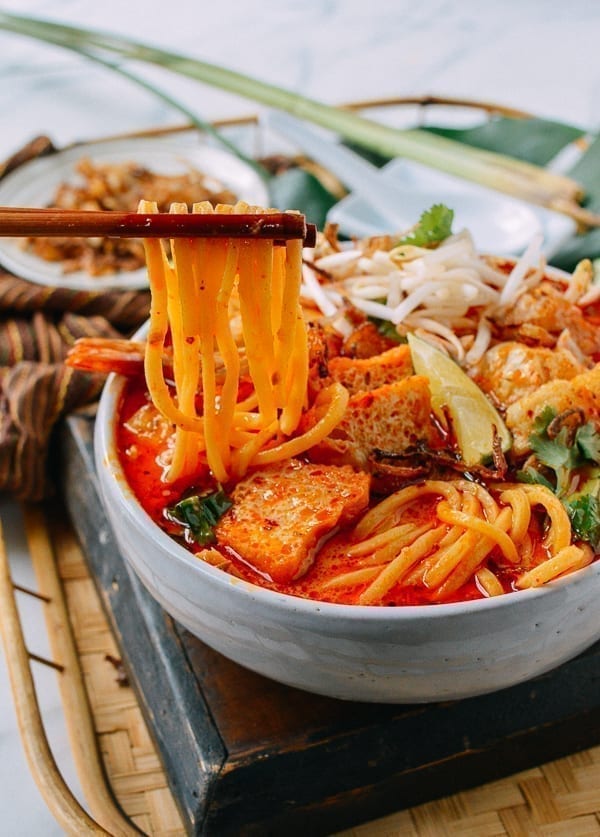
5) Laksa
Laksa is a flavorful soup that blends the tastes of Southeast Asia. It’s known for its rich, creamy coconut milk base and a spicy, aromatic laksa paste. The paste typically includes ingredients like lemongrass, ginger, garlic, chilies, and dried shrimp, ground together to create a bold, complex flavor.
To prepare laksa, start by heating oil in a large pot. Add minced garlic, ginger, and lemongrass, and sauté for a few minutes. Next, stir in the laksa paste and cook until fragrant. Pour in chicken stock and coconut milk, and bring the mixture to a simmer.
Laksa often includes proteins like chicken, shrimp, or tofu. Simmer your choice of protein in the broth until cooked through. For added texture, you can also include vegetables like bean sprouts and sliced red chilies.
Noodles are a key component of laksa. Rice noodles are a popular choice, but egg noodles can also be used. Cook the noodles separately and add them to the soup just before serving to maintain their texture.
Finish your laksa with fresh cilantro, lime wedges, and a dash of fish sauce to enhance the flavors. The result is a comforting, aromatic soup that offers a delightful balance of spice, creaminess, and umami. Enjoy your laksa hot, with each spoonful delivering a taste of Southeast Asian cuisine.
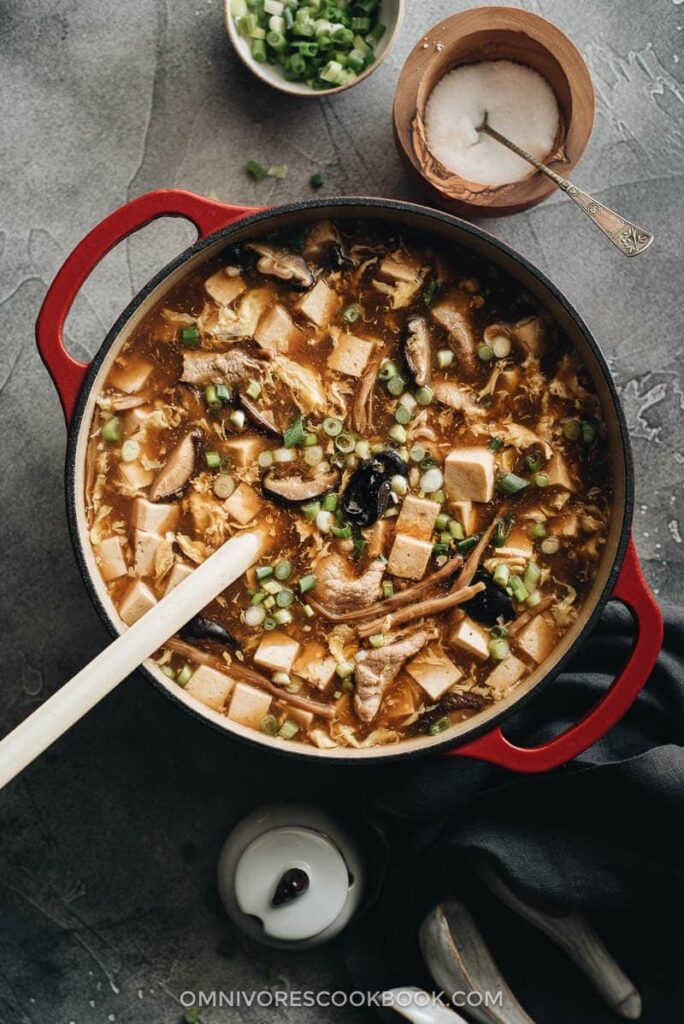
6) Hot and Sour Soup
Hot and Sour Soup is a classic favorite in Chinese cuisine. It’s known for its flavorful balance of spicy and tangy notes. This soup typically features ingredients like mushrooms, tofu, bamboo shoots, and pork or chicken. These elements create a rich and satisfying texture.
To start, you should soak dried mushrooms and lily buds for about 20 minutes. Meanwhile, prepare your other ingredients. Julienne some pork, mince fresh ginger, and mix the pork with ginger and soy sauce. Set it aside.
Next, bring your broth to a gentle simmer. Add your rehydrated mushrooms, lily buds, tofu, and bamboo shoots. Cook for a few minutes. To thicken the soup, mix cornstarch with water and slowly stir it into the broth, ensuring there are no lumps.
For the signature egg ribbons, beat an egg and pour it slowly into the soup while stirring. This will create delicate strands of egg throughout the broth. Adjust the seasoning with soy sauce, white pepper, and vinegar to taste. Enjoy your homemade Hot and Sour Soup piping hot.
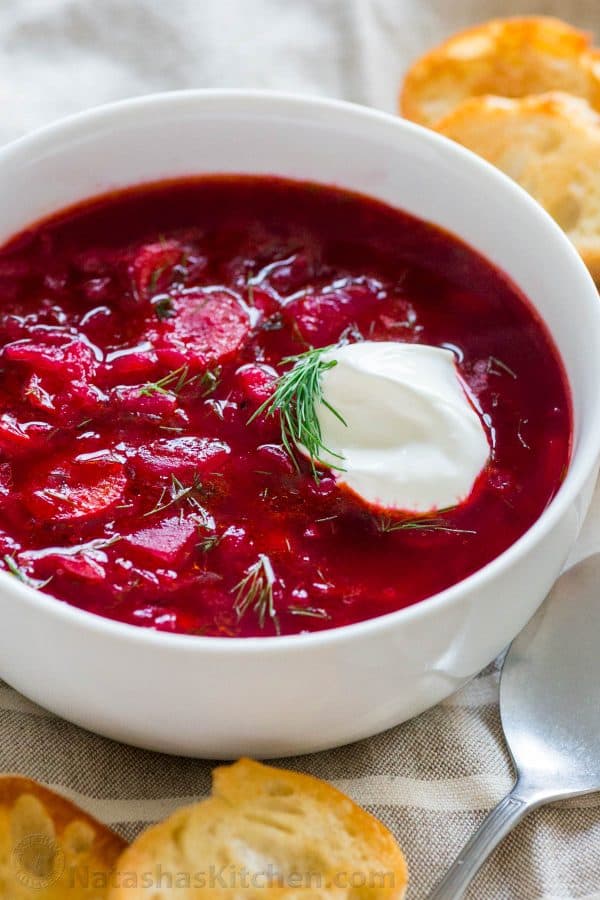
7) Borscht
Borscht is a popular soup in Eastern Europe, known for its vibrant color and hearty ingredients. When it made its way to Asia, it took on new forms and flavors.
In Hong Kong, Borscht, also known as Luo Song Tang, blends Eastern European and Chinese culinary traditions. Key ingredients include beef, potatoes, carrots, and cabbage.
To make it, you start by browning beef or oxtail in a pot. Then, add vegetables like onions, carrots, and celery.
Tomato paste and crushed tomatoes give the soup its rich flavor. Some recipes also call for ginger and bay leaves for added depth.
Simmer everything together for several hours until the meat is tender and the vegetables are soft. Season with salt, sugar, and sometimes a splash of vinegar.
You can serve Hong Kong-style Borscht with a side of crusty bread. This makes it a filling and comforting meal.
This Asian twist on traditional Borscht offers a delightful blend of flavors, perfect for a cozy dinner night. It beautifully illustrates how food can bring together different culinary worlds.
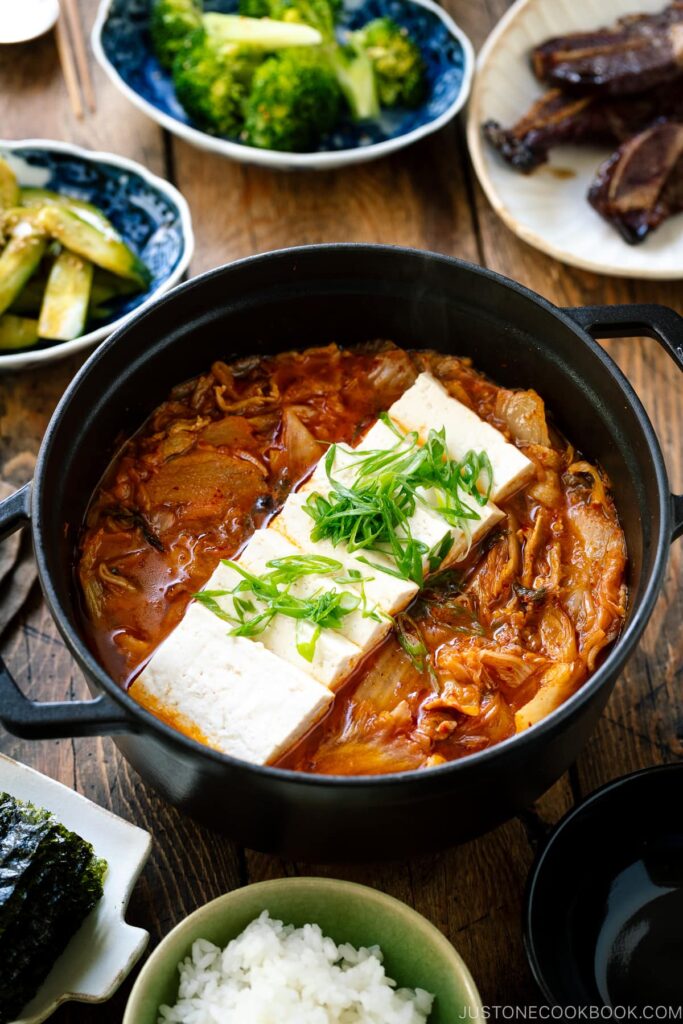
8) Kimchi Jjigae
Kimchi Jjigae, also known as kimchi stew, is a popular Korean dish made with aged kimchi and pork belly.
Start by cutting skinless pork belly into bite-size pieces. Season the pork belly with a tablespoon of rice wine and a sprinkle of black pepper.
In a large pot, heat some oil over medium-high heat. Add the pork belly and cook until it is lightly browned.
Next, add thinly sliced onions and garlic to the pot. Cook until the onions soften. Then add the kimchi.
Add gochujang, a Korean chili paste, and gochugaru, Korean chili flakes, to the pot. Mix until everything is well combined.
Once the ingredients are mixed, add broth to the pot. Allow the stew to simmer for about 10 minutes.
For added flavor, lay slices of tofu on top of the stew. Cover and let it cook for another 10 to 15 minutes.
Finish the dish by adding chopped green onions on top. 김치찌개 tastes best when served hot with a bowl of rice.
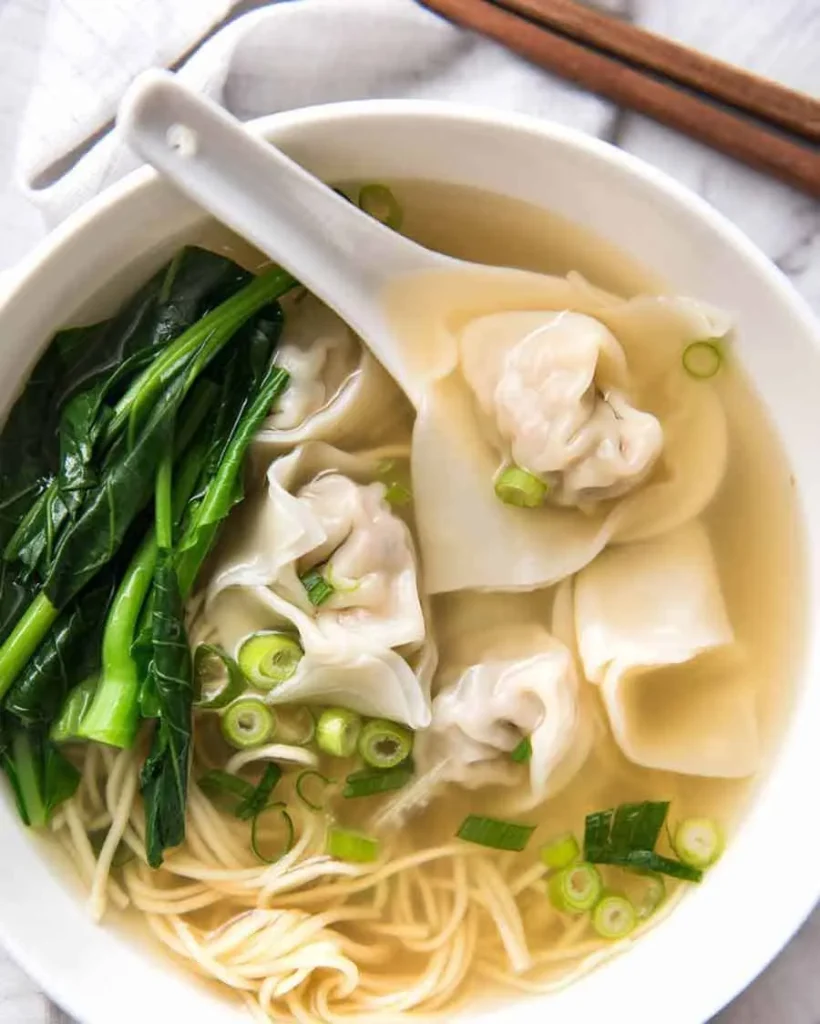
9) Wonton Soup
Wonton soup is a classic Chinese dish that is both comforting and flavorful. It typically includes wontons filled with pork or shrimp, served in a savory broth.
To prepare wontons, mix ground pork or shrimp with soy sauce, ginger, garlic, and green onions. Place a small amount of filling onto wonton wrappers, fold, and seal.
The broth for wonton soup can be made with chicken, pork bones, or a combo of both. Simmer bones with ginger, garlic, and green onions. Skim off any foam and impurities to get a clear and tasty broth.
When ready to cook, bring the broth to a boil. Add the wontons and cook until they float to the top. This usually takes about 4-5 minutes.
Finish the soup with a handful of leafy greens like bok choy or spinach. You can also add some fresh scallions on top for extra flavor.
Serve your wonton soup hot, and enjoy this delicious and warming dish anytime you need a satisfying meal.
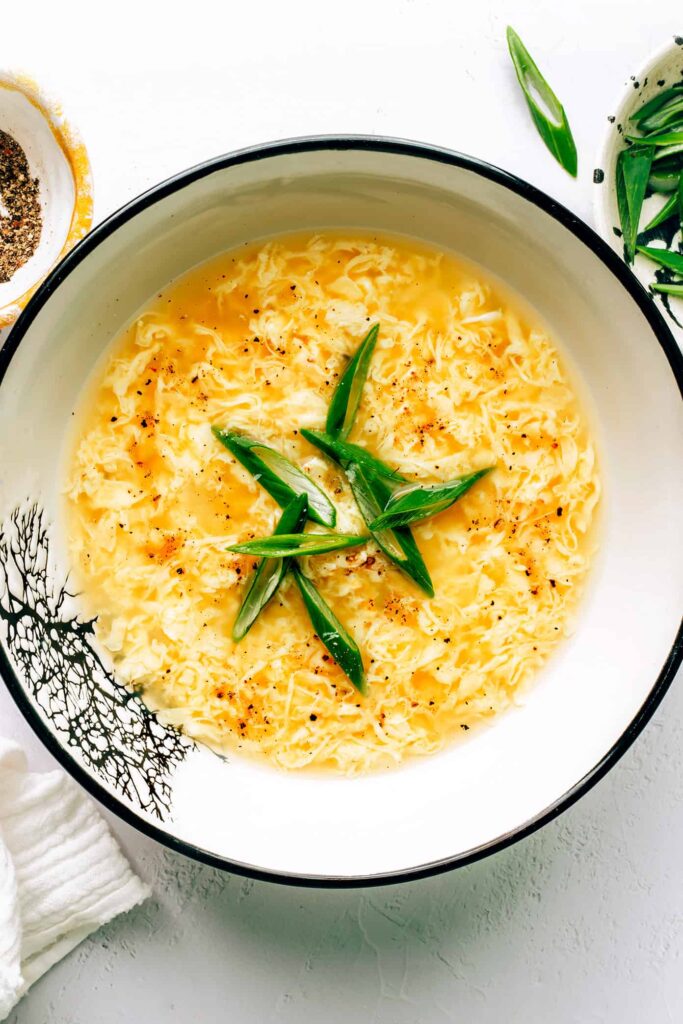
10) Egg Drop Soup
Egg Drop Soup is a simple and classic dish that you can quickly make. It’s a flavorful soup featuring delicate egg ribbons floating in a savory broth. It’s popular in both Chinese and Japanese cuisine.
To start, you’ll need chicken stock or broth for the base. If you don’t have it, you can substitute it with water mixed with chicken powder or bouillon.
Season the broth with salt, soy sauce, and a bit of white pepper. You may also add a touch of sesame oil for extra flavor.
To thicken the soup, use a cornstarch slurry. Mix cornstarch with water and whisk it into the simmering broth. Once the soup thickens, you’re ready to add the eggs.
The key to perfect egg ribbons is to slowly drizzle beaten eggs into the hot broth. Reduce the heat and pour the eggs in a thin stream while stirring gently. This technique produces the wispy “egg flowers” that define Egg Drop Soup.
Optionally, you can add a few drops of yellow food coloring or turmeric to give the soup a vibrant yellow color. Adjust the seasoning to taste before serving.
Egg Drop Soup is both nourishing and satisfying, making it a great addition to any meal.
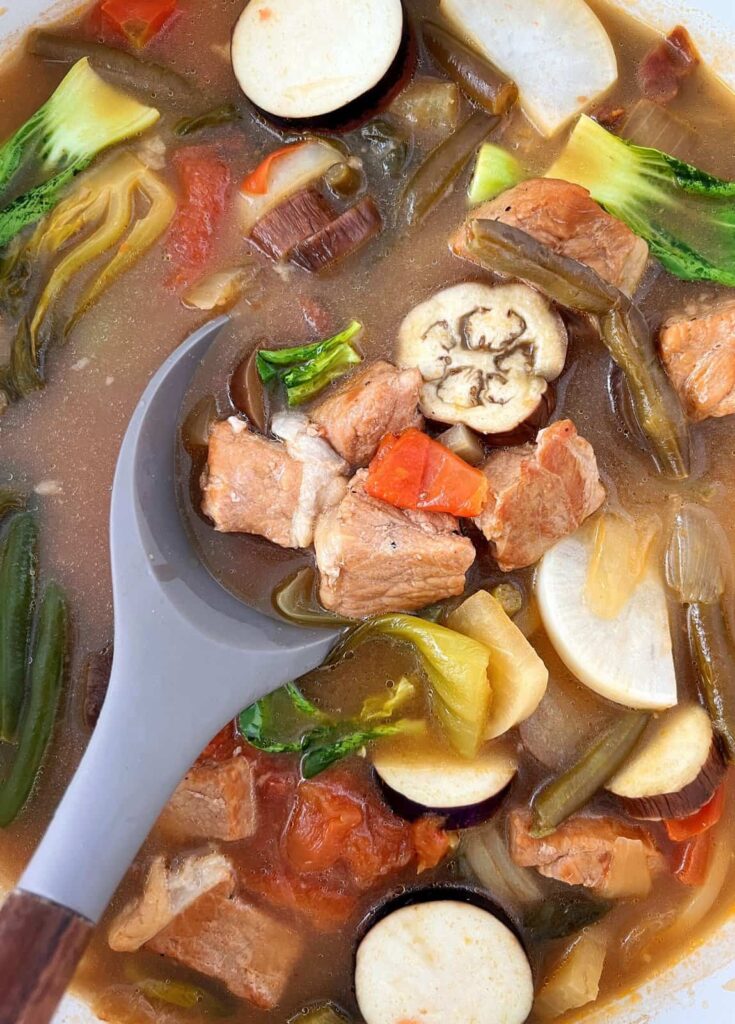
11) Sinigang
Sinigang is a popular Filipino soup known for its tangy and savory flavor. This dish usually features tamarind as the souring agent, giving the broth its distinct taste. Tamarind can be fresh or from a powdered mix.
Pork, particularly pork belly, is a common choice for the meat in Sinigang. The pork is simmered until tender, absorbing the tangy broth. Meat alternatives like shrimp or beef can also be used.
Vegetables such as tomatoes, radish, and long beans add color and texture. Leafy greens like spinach or kangkong (water spinach) are often added just before serving to maintain their fresh, vibrant nature.
To prepare Sinigang, you start by boiling the tamarind in water to make the base for the soup. Next, add the meat and let it simmer, followed by onions and tomatoes. Fish sauce enhances the savory notes.
Adjust the sourness by adding more tamarind or even lemon if preferred. Served hot, it’s often paired with steamed rice, making it a hearty meal perfect for any weather.
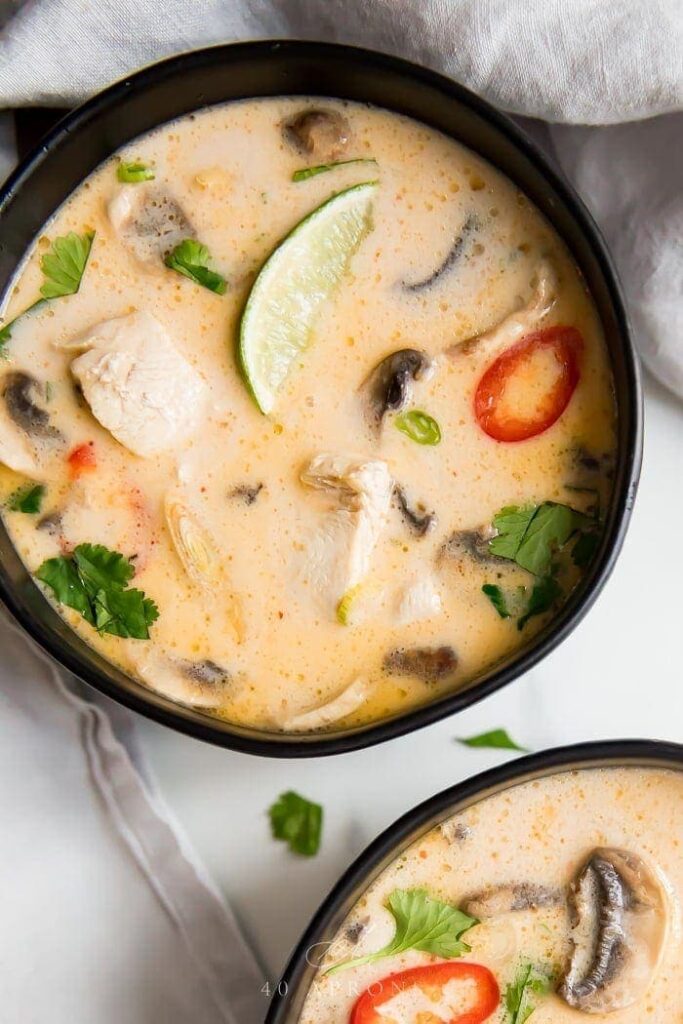
12) Thai Coconut Soup
Thai Coconut Soup, also known as Tom Kha, is a delicious and fragrant dish. It combines the rich flavors of coconut milk with the spicy taste of curry paste.
To start, you’ll need to heat some oil in a large pot. Once hot, add fresh ginger, lemongrass, and curry paste. Let these ingredients cook for about a minute.
Next, pour in chicken or vegetable broth. Stir in fish sauce and a bit of brown sugar for a touch of sweetness. Let the mixture simmer on low heat for 15 minutes to develop the flavors.
Add the coconut milk and any vegetables you like, such as carrots, mushrooms, or peppers. Allow everything to cook until the vegetables are tender. This usually takes around 10 minutes.
For a bit of protein, you can add chicken, tofu, or shrimp. Simmer these until they are fully cooked. Serve your soup hot, and enjoy the blend of spicy, sweet, and savory tastes.
This soup is perfect for a comforting meal that’s flavorful and warming. Experiment with different ingredients to make it your own.
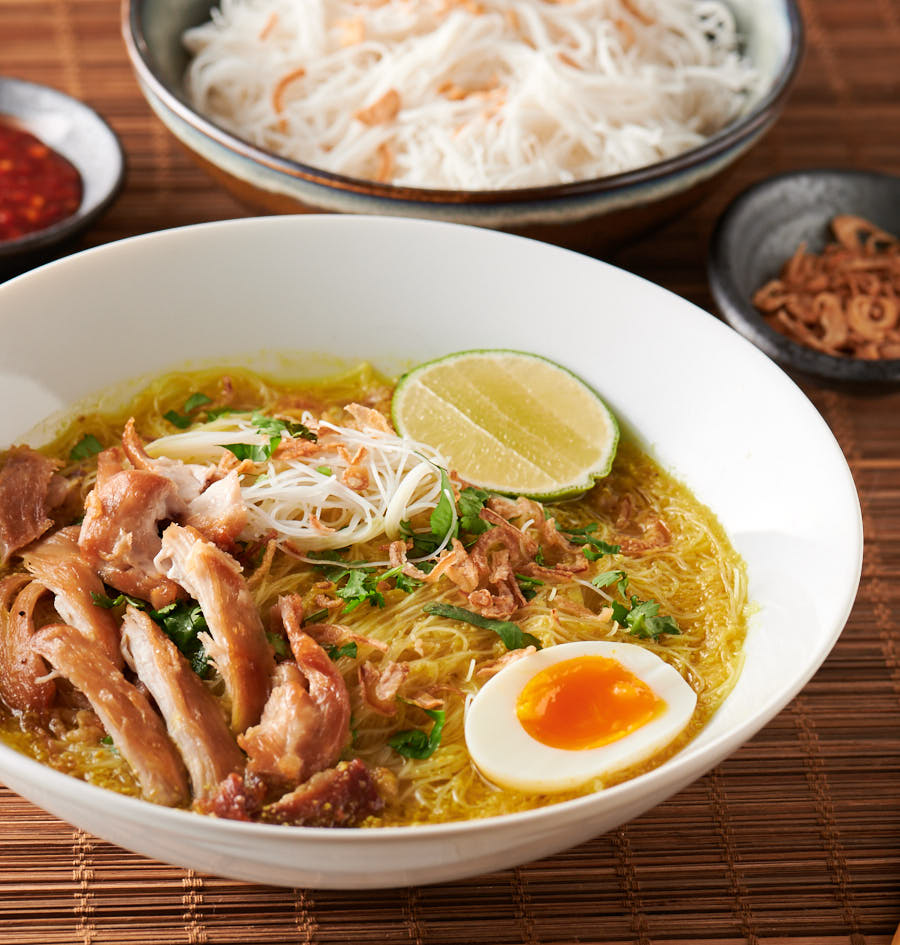
13) Soto Ayam
Soto Ayam is a popular Indonesian chicken soup. It is known for its bright yellow color from turmeric and rich flavors from various spices.
To make Soto Ayam, you start by boiling chicken with lemongrass, lime leaves, and salt. Remove the chicken and use it later for shredding. Keep the broth clear by skimming any foam.
Next, create a spice paste with ingredients like turmeric, ginger, and garlic. Stir this paste into the broth and let it simmer. This step adds depth to the soup’s flavor.
Soak vermicelli noodles in hot water until tender. Drain and place these noodles in serving bowls. Add shredded chicken, hard-boiled eggs, and some fresh lime juice.
Pour the hot soup over the ingredients in each bowl. Garnish with coriander leaves and a wedge of lime. Some people also like to add sambal oelek for a spicy kick.
Soto Ayam is usually served with a side of steamed rice or crispy prawn crackers. This dish is enjoyed throughout Indonesia and is perfect for a comforting meal.
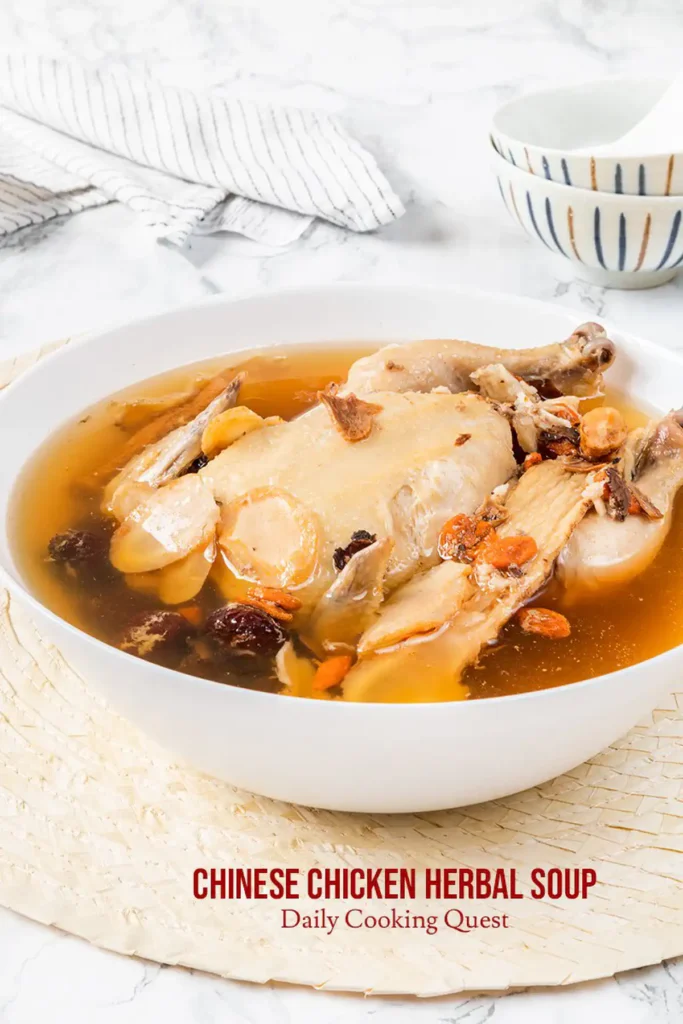
14) Chinese Herbal Soup
Chinese herbal soup is a nourishing dish that uses traditional herbs. You start by soaking dried herbs like fox nut barley, lotus seeds, Chinese yam, and poria cocos mushrooms.
Pork bones are often used for the broth. Soak them in cold water for about an hour, then rinse and drain. Place them in a pot with enough cold water to cover.
Add the soaked herbs to the pot. Bring the mixture to a boil and then reduce the heat to simmer. Cook until the flavors blend together, usually a few hours.
Some recipes include chicken and other herbs like goji berries. Add these ingredients towards the end of cooking and let the soup simmer for another 20 minutes.
Chinese herbal soup is not just tasty; it’s considered good for your health. It’s a delightful way to warm up and enjoy traditional flavors.
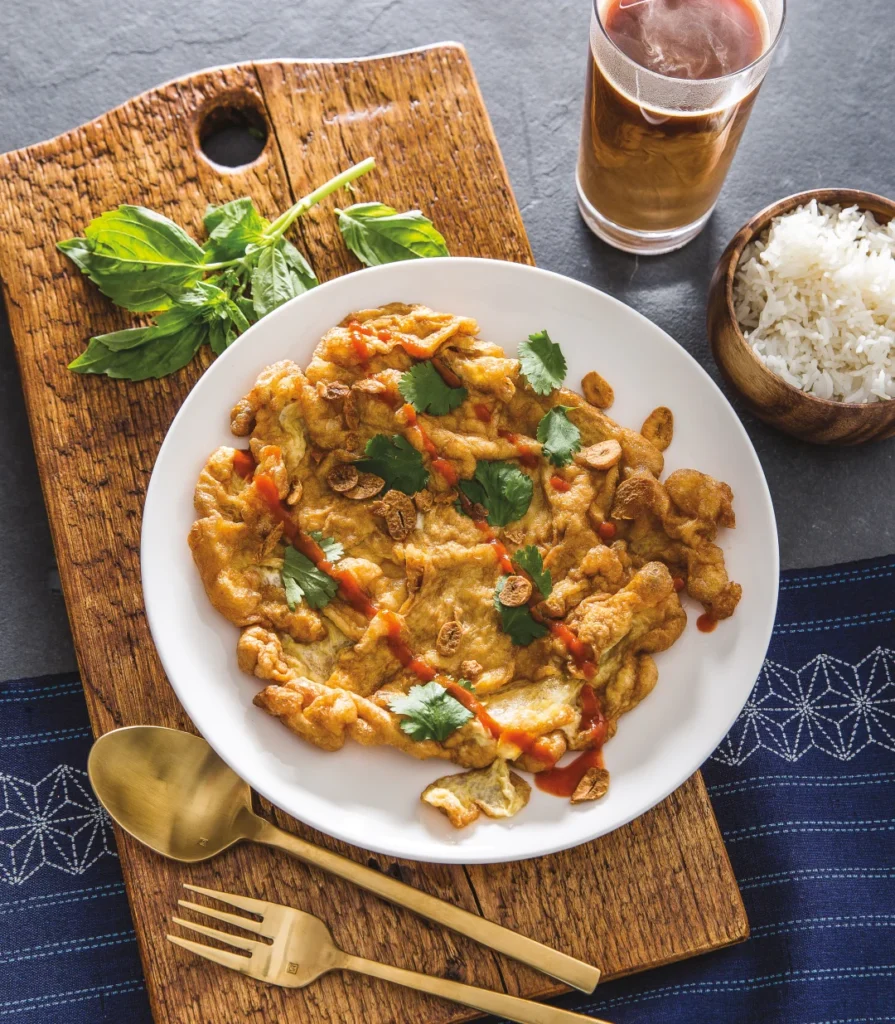
15) Kai Chiew
Kai Chiew is a comforting Thai soup known for its eggy goodness. This dish is simple yet satisfying, often enjoyed as a light meal.
You start by beating eggs and pouring them into a pot of hot chicken broth. As the egg hits the broth, it forms delicate ribbons.
Kai Chiew is often seasoned with fish sauce and garnished with green onions and cilantro. Some variations also include bits of minced pork for added flavor.
This soup is a great option when you want something quick and easy. The ingredients are basic, and it takes only a few minutes to prepare.
Kai Chiew is perfect for any time of the day. Serve it with a bowl of rice or enjoy it on its own. This dish is popular among both kids and adults for its mild yet savory taste.
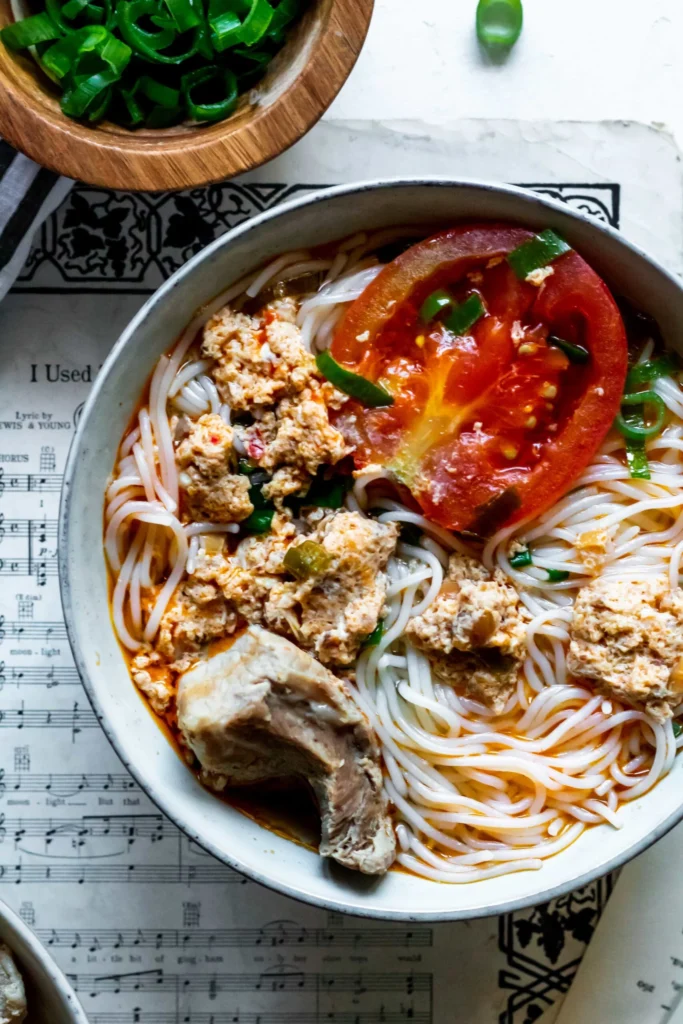
16) Vietnamese Crab Noodle Soup
Vietnamese Crab Noodle Soup, known as Bún Riêu, is a flavorful and hearty dish. It features a rich broth made from pork bones simmered for hours. This creates a deep, savory base for the soup.
To prepare the broth, cook the pork bones in boiling water for a few minutes. Discard the water, then add fresh water and boil the bones for at least one hour.
In a separate pan, sauté garlic and shallots in oil until light brown. Add tomatoes and stir-fry until they are soft. This mixture gives the soup its rich color and slightly tangy flavor.
The soup also includes crab paste, which adds a unique and delicious taste. Heat crab paste with garlic and tomatoes, then add it to the broth. This blend of flavors creates the characteristic taste of Bún Riêu.
Prepare the noodles by cooking them in boiling water until al dente. Rinse with cold water and set aside.
Serve the soup by adding the prepared noodles to a bowl. Ladle the hot broth over the noodles. Garnish with fresh herbs like cilantro and green onions.
Enjoy this vibrant and satisfying Vietnamese Crab Noodle Soup.
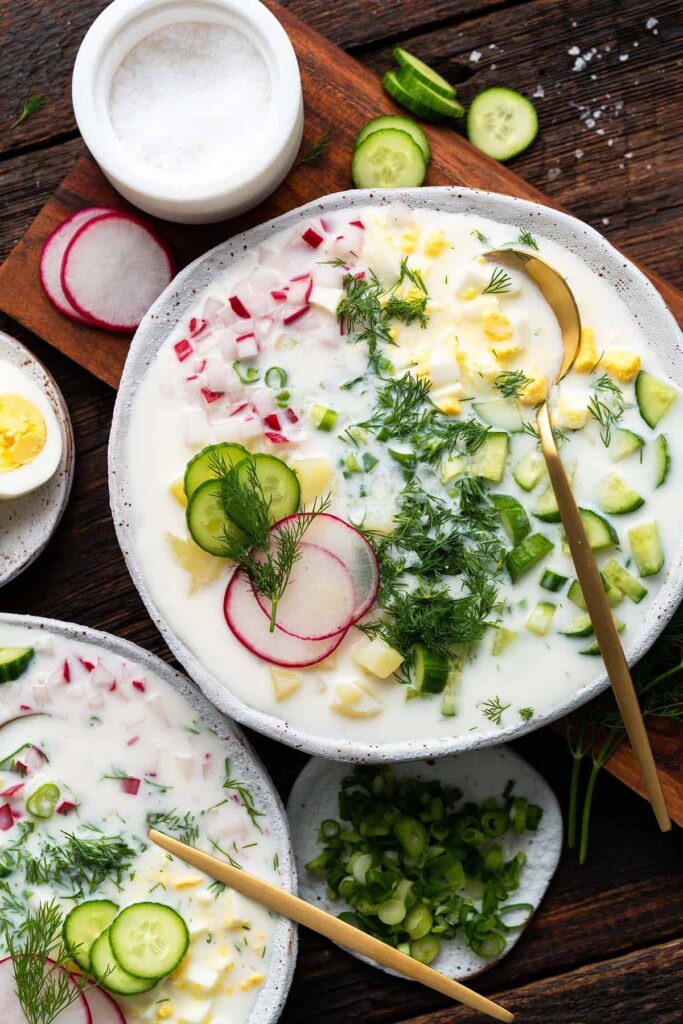
17) Okroshka
Okroshka is a traditional Russian cold soup, perfect for hot summer days. This refreshing dish typically combines diced vegetables, meat, and a tangy base. You can use ingredients like cucumbers, radishes, potatoes, and hard-boiled eggs.
Add cooked meat such as ham or sausage. Alternatively, you can use a mix of kefir and cold water or even buttermilk for the liquid base.
Chop vegetables like cucumbers, radishes, and scallions finely. Then, mix in the diced potatoes, eggs, and meat. Fresh herbs such as dill or parsley add extra flavor.
In a large pitcher, mix the kefir or buttermilk with cold water. Adjust the thickness by adding more water if needed. Pour the liquid mixture over the chopped ingredients.
Serve Okroshka cold, garnished with more fresh herbs. A bit of sour cream on top enhances the taste. This soup is a simple, healthy, and delicious way to cool down on a warm day.
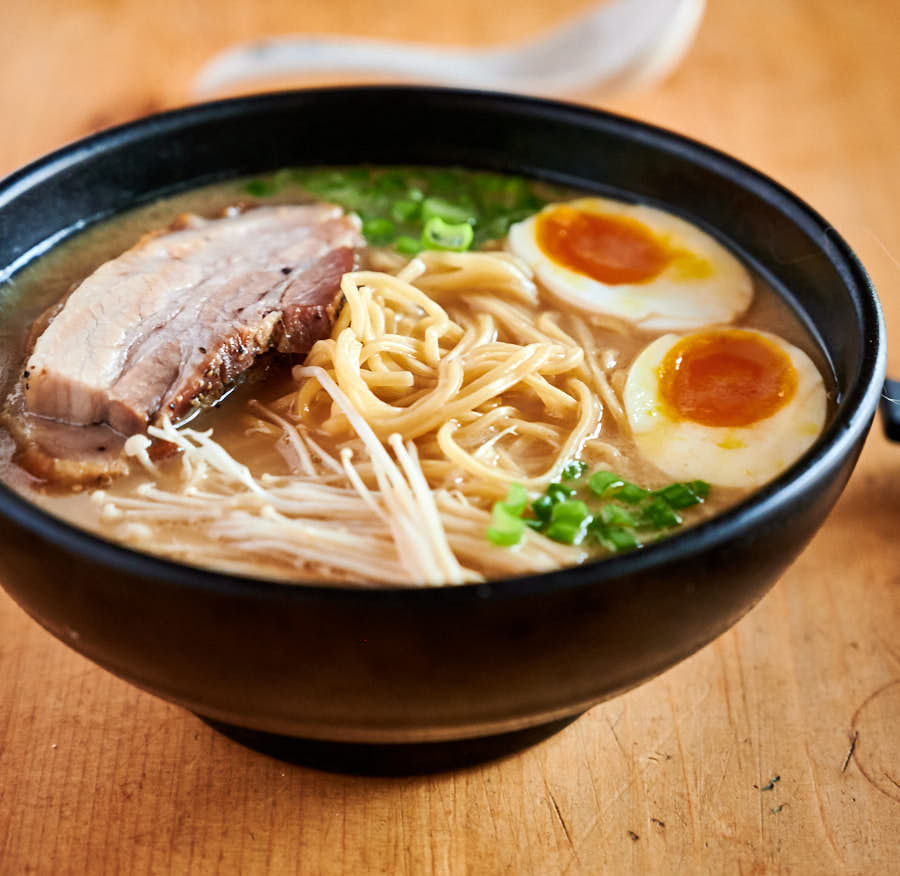
18) Tonkotsu Ramen
Tonkotsu Ramen is a flavorful Japanese noodle soup. It features a rich, creamy broth made from pork bones.
To start, you need to prepare the broth. Simmer pork bones for hours until they break down, creating a thick, milky-white base.
Next, strain the broth to remove any bone fragments. Some recipes suggest straining through cheesecloth for a cleaner finish.
As the broth simmers, prepare the ramen toppings. Common toppings include chashu pork, green onions, and boiled eggs.
For the noodles, cook them according to the package instructions. Fresh ramen noodles are preferred for their chewy texture.
When the broth is ready, combine it with the cooked noodles. Add the toppings and your favorite garnishes. Popular garnishes are sesame seeds, mushrooms, and nori.
Tonkotsu Ramen is known for its savory and satisfying taste. It’s a great choice for a hearty meal. Make sure to enjoy it hot, as the rich flavors are best enjoyed this way.
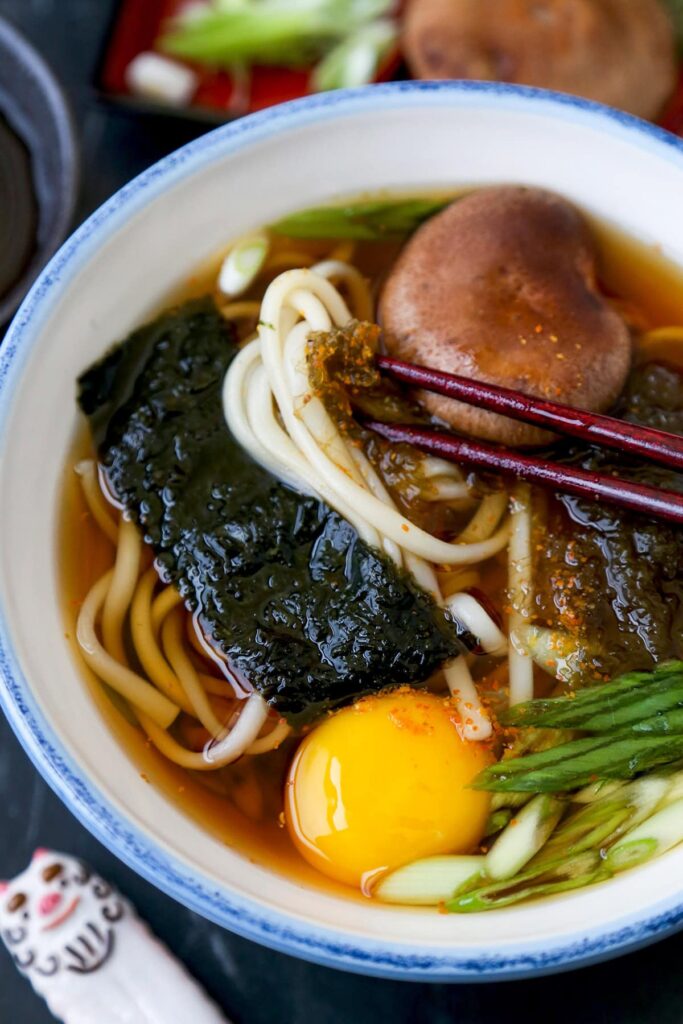
19) Udon Soup
Udon soup is a popular Japanese dish known for its thick, chewy noodles and flavorful broth. You can make Udon soup with a variety of ingredients, making it versatile and tasty.
Start by boiling a large pot of water. Add your udon noodles and cook them according to the package instructions. This usually takes about 2-3 minutes for frozen Sanuki udon or a bit longer for dried noodles.
While the noodles cook, prepare your broth. Combine water, mentsuyu (concentrated noodle soup base), and mirin in a pan. Bring this mixture to a simmer over medium heat. Once it simmers, remove it from the heat and cover it with a lid.
For a heartier soup, you can add chicken, mushrooms, and bok choy. First, bring chicken broth, ginger, chili powder, and garlic to a boil. Add the chicken and vegetables, reducing the heat to let it simmer for a few minutes. Then, add the cooked udon noodles to the pot.
After everything is combined, taste the broth and adjust the seasoning as necessary. Distribute the noodles and soup into individual bowls. Top with green onions or sesame seeds if you like. Enjoy your warm, comforting bowl of udon soup!
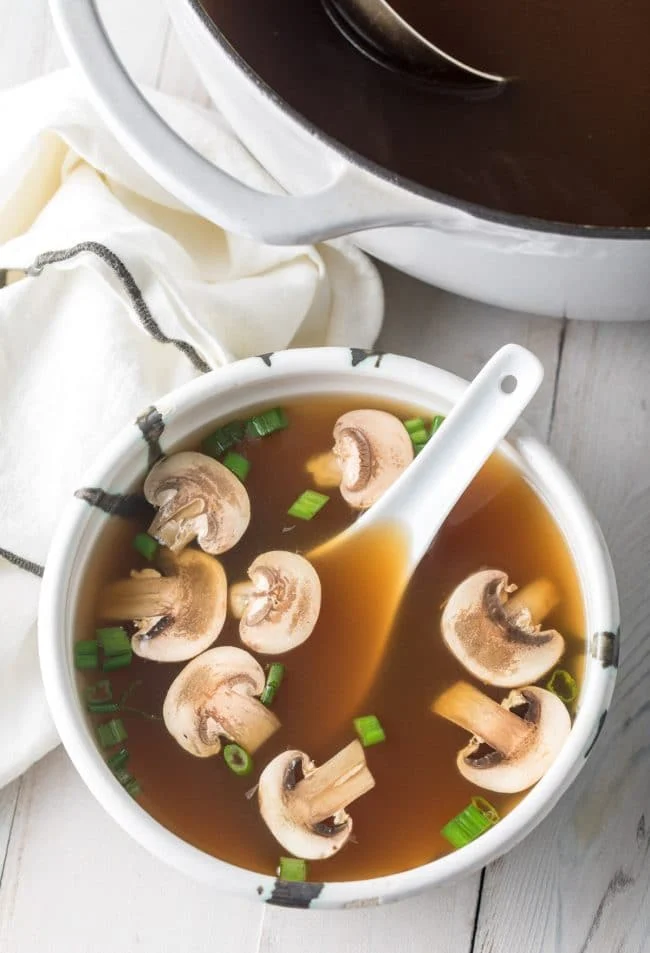
20) Japanese Clear Soup
Japanese Clear Soup, often called “Osumashi,” is a soothing dish known for its simplicity and gentle flavors. The broth is usually made from dashi, a traditional Japanese stock, combined with a light soy sauce and a pinch of salt.
To make this soup, start by sautéing vegetables like onions, garlic, carrots, and ginger to bring out their sweetness. After they are caramelized, add chicken and beef broths along with water to create a rich, flavorful base.
Once the broth simmers, strain out the solids to achieve a clear, clean liquid. This clear broth is then served with simple garnishes like thinly sliced mushrooms and green onions.
Some versions of Japanese Clear Soup also include kamaboko fish cake slices or shiitake mushrooms to add a bit of texture and taste.
This soup is not only a popular starter in Japanese cuisine but also a favorite at many Japanese steakhouses, often served before the main course to cleanse your palate.
Making this soup at home is straightforward and can be a delightful way to start your meal.
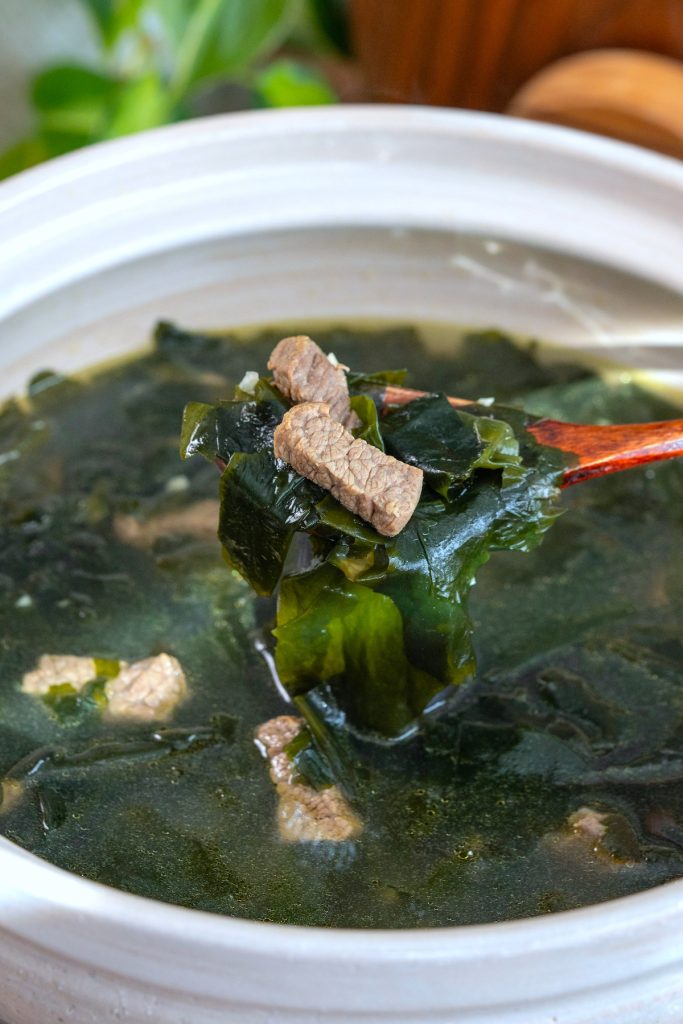
21) Korean Seaweed Soup
Korean Seaweed Soup, known as Miyeok Guk, is a staple in Korean cuisine. It’s often enjoyed on birthdays and after childbirth for its nutritious benefits. This soup is simple but flavorful.
To make Miyeok Guk, you start by soaking dried seaweed in water for about 10-15 minutes until it blooms. Drain and chop the seaweed into bite-sized pieces.
In a deep pot, sauté beef in sesame oil over medium heat until it starts to brown. Add chopped garlic to the pot and cook until fragrant. Pour in water and rice water to create the soup base.
Next, add the seaweed and let it simmer. Season with soy sauce, salt, and pepper to taste. Cook until the beef is tender and the broth becomes slightly milky, about 20-30 minutes.
Miyeok Guk is both comforting and nourishing. Its savory broth combined with the texture of soft seaweed and tender beef makes it a beloved dish in Korean households.
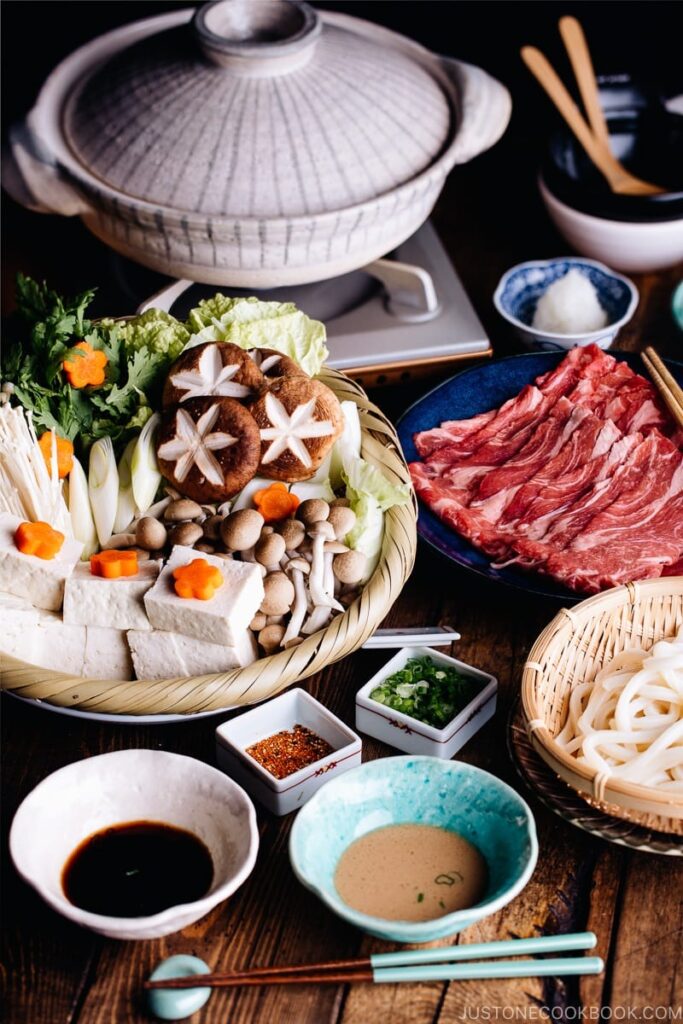
22) Shabu Shabu
Shabu Shabu is a popular Japanese hot pot dish. It features thinly sliced meat and vegetables cooked quickly in a pot of simmering broth.
To prepare, you start by arranging your ingredients on platters. Common items include beef, tofu, cabbage, mushrooms, and spinach.
Set a pot with broth on a burner in the middle of your table. Once the broth is boiling, reduce the heat to keep it at a simmer.
Cook your vegetables first. Leafy vegetables usually take about 10 minutes.
Next, cook the meat. Using long chopsticks, dip each piece of meat into the broth for a few seconds. The meat cooks quickly due to its thinness.
Serve the cooked ingredients with dipping sauces. Ponzu and sesame sauces are traditional choices.
You can also add noodles or rice to complete the meal. Place them in individual bowls for each person at the table.
With its communal cooking and fresh ingredients, Shabu Shabu offers a fun and interactive dining experience.
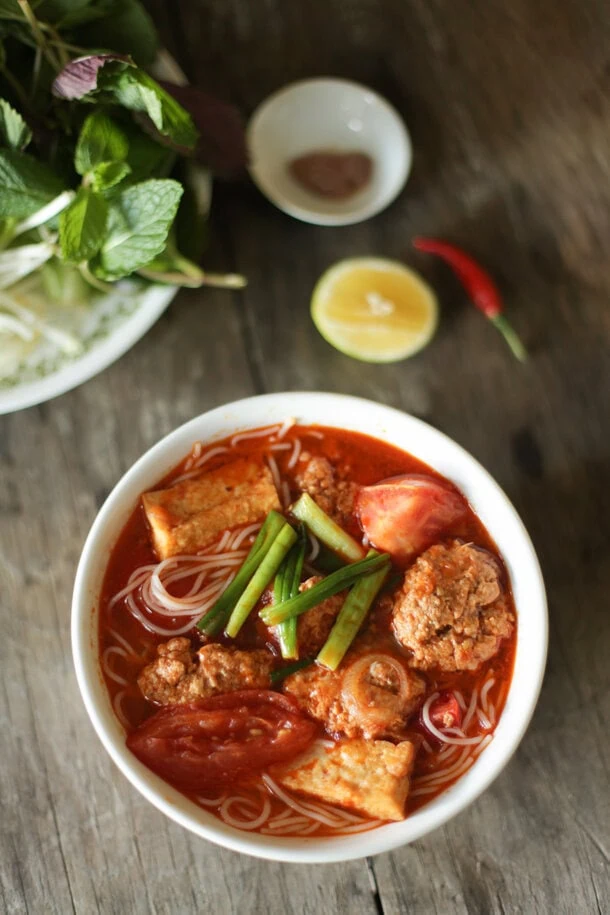
23) Bun Rieu
Bun Rieu is a Vietnamese crab and tomato noodle soup. It’s a hearty dish with a mix of tangy, savory flavors. The soup base is made from tomatoes, crab paste, and often pork or shrimp.
First, sauté sliced shallots in oil until they turn light brown. Add quartered tomatoes and stir fry for a few minutes until they soften. This forms part of the soup’s base.
Next, combine the sautéed tomatoes and shallots with chicken broth, water, rock sugar, chicken bouillon powder, and fish sauce. Bring everything to a boil, then lower the heat and let it simmer.
For the protein, mix fresh crab meat, shrimp paste, and beaten eggs together. Form this mixture into small meatballs known as “riêu.” These add a delicious, seafood-rich flavor to the soup.
Meanwhile, cook pork hocks in water until they are tender. Pork hocks offer a rich, deep flavor that complements the other ingredients.
Add all elements—broth, meatballs, pork hocks—together and simmer. This allows the flavors to meld beautifully.
Serve your Bun Rieu with vermicelli noodles and garnish with herbs like cilantro and mint. You can also offer lime wedges and chili paste for extra flavor. This soup makes for a comforting, flavorful meal.
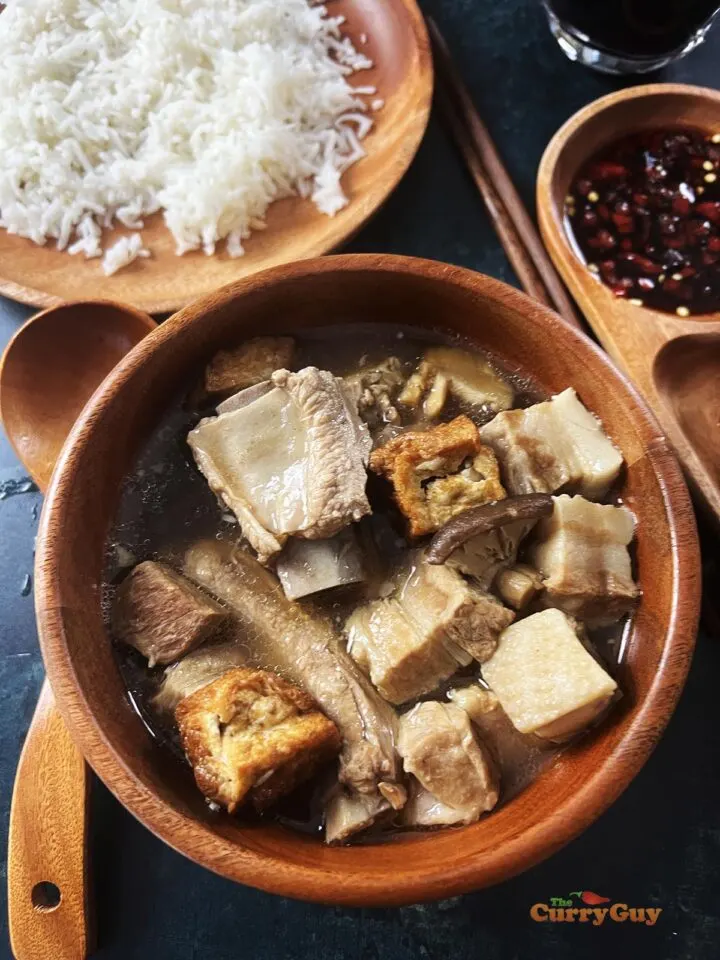
24) Bak Kut Teh
Bak Kut Teh is a savory pork rib soup popular in Southeast Asia. The name translates to “meat bone tea.” It’s a hearty dish made with a blend of herbs and spices that create a rich and flavorful broth.
You will need pork ribs and a mix of Chinese herbs to start. Common herbs include star anise, cinnamon sticks, and cloves. These are sometimes sold as a packaged mix in Asian grocery stores.
Begin by blanching the pork ribs to remove impurities. Place the ribs in a pot of cold water and bring it to a boil. After a few minutes, discard the water and rinse the ribs.
In a clean pot, add water, the blanched ribs, and the herb mix. Bring it to a boil, then reduce the heat and let it simmer. Cooking slowly ensures that the meat becomes tender and the flavors meld well.
You can also add garlic and white pepper for an extra kick. Some recipes include mushroom or tofu to add more texture.
Serve Bak Kut Teh hot, with steamed white rice or noodles. You can also enjoy it with a side of fried dough sticks for dipping into the flavorful broth.
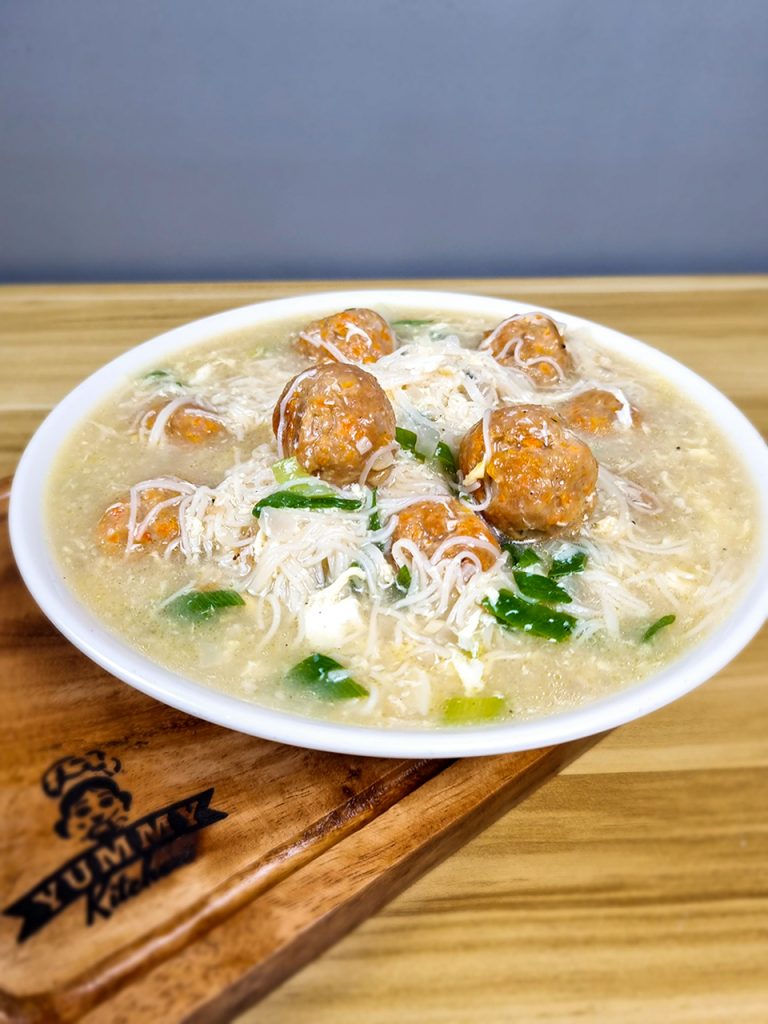
25) Misua Soup
Misua Soup is a comforting noodle soup that features thin, wheat-based misua noodles. It is popular in many Asian countries, especially during celebrations like Lunar New Year.
You start by preparing the broth. Use chicken or pork broth as the base. For added depth, include seasonings like fish sauce, soy sauce, or oyster sauce.
The soup often includes meatballs. Combine ground pork with chopped onions, soy sauce, eggs, bread crumbs, and black pepper. Mix well and shape into small meatballs. These meatballs are either fried or directly simmered in the broth.
Vegetables add freshness to the soup. Common choices are Chinese cabbage, carrots, and wood ear mushrooms. Sauté the vegetables briefly before adding them to the broth.
Cook the misua noodles directly in the broth. They only need a few minutes to soften. Be careful not to overcook, as these noodles can become mushy.
Once the noodles are ready, turn off the heat. Serve the soup hot, garnished with chopped green onions or cilantro. Misua Soup is not only delicious but also easy to make, making it a perfect choice for any occasion.
Health Benefits of Asian Soups
Asian soups provide numerous health benefits, mainly due to their immune-boosting properties and the nutrient-rich ingredients they contain.
Immune-Boosting Properties
Many Asian soups are packed with natural ingredients that help boost your immune system. For instance, garlic and ginger are common in these soups and are known for their antiviral and antibacterial properties. These ingredients can help your body fight off infections and reduce inflammation.
Some soups include herbs like lemongrass and turmeric. Lemongrass can help detoxify your body and fight off harmful bacteria. Turmeric contains curcumin, which has anti-inflammatory and antioxidant benefits. These help improve your overall health and strengthen your immune system.
Bone broth is another staple in many Asian soups. It is rich in vitamins and minerals like calcium, magnesium, and phosphorus. These nutrients support your immune function and promote overall wellness.
Nutrient-Rich Ingredients
Asian soups often use fresh vegetables, lean proteins, and whole grains, making them nutrient-dense. Vegetables like bok choy, mushrooms, and spinach are high in vitamins A, C, and K. These vitamins are essential for maintaining healthy skin, vision, and blood clotting functions.
Lean proteins such as tofu, chicken, or seafood provide essential amino acids needed for muscle repair and growth. These proteins are also easier to digest compared to red meats, making them a healthier choice.
Whole grains like rice and quinoa are often added to Asian soups. These grains are high in fiber, which helps improve your digestion and keeps you feeling full longer. Fiber also helps regulate your blood sugar levels and supports heart health.
Asian soups are also typically low in unhealthy fats and sugars, making them a healthy meal option that can fit into various dietary needs.
Cultural Significance of Soup in Asian Cuisine
Asian soups are more than just meals; they are an integral part of cultural practices and traditions. Different regions have unique ingredients and preparation methods that highlight the diversity and historical richness of the continent.
Historical Context
Soup has been a staple in Asian cuisine for thousands of years. From Chinese herbal broths to Japanese miso soups, each type carries historical significance. In ancient China, soups were often used for medicinal purposes, integrating herbs and roots believed to promote health. These practices continue today, showing the deep-rooted belief in the healing power of food.
In Japan, miso soup is a tradition passed down through generations. Made from fermented soybean paste, it represents the Japanese philosophy of using simple, natural ingredients. Korean soups, like kimchi jjigae, have historical roots tied to long winters, where preserved vegetables were essential for sustenance.
Regional Variations
Asian soups vary significantly from one region to another, reflecting local ingredients and cultural practices. In Thailand, Tom Yum Soup is famous for its spicy and sour flavor, using shrimp, lemongrass, galangal, and kaffir lime leaves. The combination provides a unique taste experience that is both refreshing and invigorating.
In Vietnam, Pho is a popular soup that showcases the country’s love for complex broths. Made from beef or chicken, it includes rice noodles and fresh herbs, like basil and mint. This dish is typically enjoyed as a comforting breakfast or lunch.
In China, you find a wide variety of soups. Hot and sour soup and wonton soup are common, each using different techniques and ingredients. Hot and sour soup balances vinegar and white pepper, while wonton soup features delicate dumplings in a clear, savory broth.
Each type of soup tells a story about the culture it comes from, using local elements to create flavors that are both unique and deeply connected to their origins.
Common Ingredients in Asian Soups
Asian soups are known for their rich, complex flavors. These flavors often come from a combination of specific ingredients that vary by region. You will see a blend of unique broths, aromatic herbs and spices, and a variety of proteins and vegetables.
Broths and Stocks
Broths and stocks are the base for most Asian soups. Dashi is a Japanese stock made from dried kelp and bonito flakes. It adds an umami flavor. Miso paste is often used to create a rich and salty broth in Japanese soups.
Chicken, beef, or pork bones are simmered for hours to make a hearty broth in Chinese cuisine. Shrimp and fish stocks are common in Thai and Vietnamese soups, adding a distinct seafood flavor. Coconut milk is often used in Thai soups for a creamy texture.
Herbs and Spices
Herbs and spices give Asian soups their unique and memorable flavors. Lemongrass, galangal, and kaffir lime leaves are popular in Thai soups like Tom Yum. They add citrusy and earthy notes. Ginger and garlic are staples in many Asian recipes, offering warmth and depth.
Cilantro and basil are frequently used as garnishes in Vietnamese and Thai soups. Red curry paste and chilies provide the heat in many Thai soups. Soy sauce, fish sauce, and oyster sauce are common liquid seasonings used to enhance flavor.
Proteins and Vegetables
Proteins in Asian soups vary widely. Chicken, beef, pork, and shrimp are frequent choices. Tofu is also popular, especially in vegetarian or lighter soups. Eggs, either poached or boiled, can add richness and texture.
Vegetables like bok choy, mushrooms, and carrots are commonly used. Seaweed and bamboo shoots add unique textures and flavors. Noodles, whether rice or egg-based, are often included to make the soup heartier.
These ingredients are key to creating the balance of flavors that makes Asian soups so beloved.
